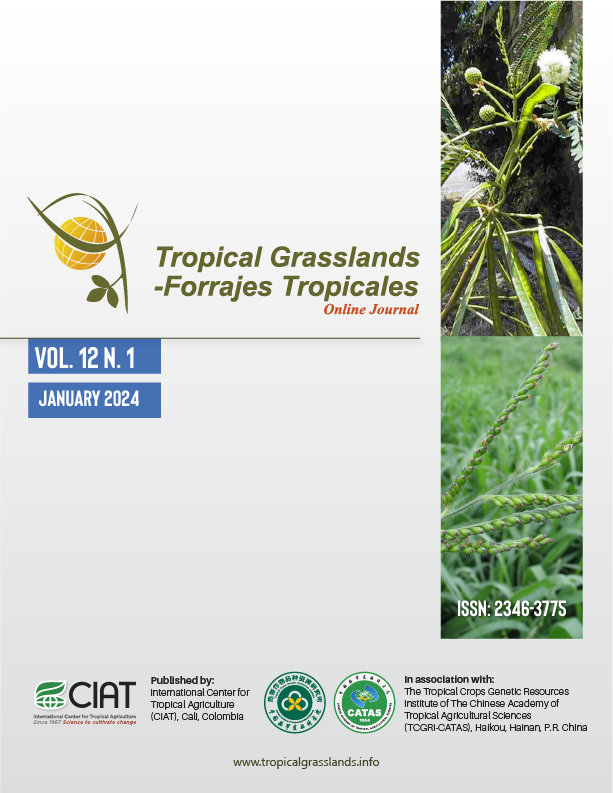La concentración de mimosina en la leucaena gigante (Leucaena leucocephala subsp. glabrata) fluctúa con la edad y la parte de la planta
Mimosine concentration in giant leucaena
DOI:
https://doi.org/10.17138/tgft(12)11-23Resumen
La leucaena gigante es una leguminosa multipropósito que se encuentra en los trópicos y subtrópicos. Su follaje se utiliza como forraje para animales debido a su alto contenido de proteínas y fibra. La leucaena gigante presenta otras características ventajosas, como un rápido crecimiento, altos rendimientos y una fuerte tolerancia a las tensiones ambientales. A pesar de tener estas cualidades deseables, los tejidos de la leucaena contienen un atributo indeseable, un aminoácido no proteico tóxico llamado mimosina, presente en todas las partes de la planta, incluido el follaje. El objetivo de esta investigación fue determinar las concentraciones de mimosina en diferentes tejidos y etapas de vida de las plantas de leucaena gigante para el uso informado del follaje de leucaena como forraje. La mimosina se extrajo de diferentes partes de la leucaena gigante en diferentes edades y se cuantificó mediante análisis de HPLC. Se utilizó qRT-PCR para determinar la expresión relativa de la mimosina sintasa en los tejidos de leucaena. La mimosina estaba presente en todas las partes de la hoja, tallo y raíz de la leucaena gigante, y las concentraciones variaban según la edad de la planta. Las semilla verdes tuvieron el nivel más alto de mimosina sintasa. La mimosina está presente en forma abundante en todos los tejidos de leucaena, pero los mayores contenidos de mimosina se presentan en las plantas y tejidos más jóvenes que en las plantas y tejidos más maduros.
Biografía del autor/a
Michael Honda, Department of Molecular Biosciences and Bioengineering, College of Tropical Agriculture and Human Resources, University of Hawaii at Manoa, Honolulu, HI, USA.
Michael Honda completed PhD in Molecular Biosciences and Bioengineering recently. He is currently a postdoctoral researcher at the University of Hawaii at Manoa.
Dulal Borthakur, Department of Molecular Biosciences and Bioengineering, College of Tropical Agriculture and Human Resources, University of Hawaii at Manoa, Honolulu, HI, USA
Professor, Department of Molecular Biosciences & Bioengineering
Referencias bibliográficas
Agbo AN; Balogun JK; Oniye SJ; Auta J. 2017. Effect of different processing methods on nutritional composition of Leucaena leucocephala (Lam De Wit) leaves as inclusion in fish feed. Journal of Applied Environmental Management. 21(4):719–725. doi: 10.4314/jasem.v21i4.12
Anitha R; Jayavelu S; Murugesan K. 2005. Antidermatophytic and bacterial activity of mimosine. Phytotherapy Research 19(11):992–993. doi: 10.1002/ptr.1761
Bageel A; Borthakur D. 2022. The effects of pH, salinity, age of leaves, post-harvest storage duration, and psyllid infestation on nutritional qualities of giant leucaena fodder. Journal of Crop Science and Biotechnology. 25:381–392. doi: 10.1007/s12892-021-00139-9
Bageel A; Honda MDH; Carillo JT; Borthakur D. 2020. Giant leucaena (Leucaena leucocephala subsp. glabrata): a versatile tree-legume for sustainable agroforestry. Agroforestry Systems 94:251–268. doi: 10.1007/s10457-019-00392-6
Brewbaker JL. 2016. Breeding leucaena: tropical multipurpose leguminous tree. In: Janick J, ed. Plant Breeding Reviews 40. Wiley‐Blackwell, Inc., Hoboken, NJ, USA. p. 43–121. doi: 10.1002/9781119279723.ch2
Crounse RG; Maxwell JD; Blank H. 1962. Inhibition of growth of hair by mimosine. Nature 194:694–695. doi: 10.1038/194694b0
Da Silva Rodrigues-Honda KC; Honda MDH; Borthakur D; Fett-Neto AG. 2022. Methods of mimosine extraction from Leucaena leucocephala (Lam.) de Wit leaves. In: Fett-Neto AG, ed. Plant Secondary Metabolism Engineering. Methods in Molecular Biology, vol 2469. Humana, New York, NY, USA. p. 231–237. doi: 10.1007/978-1-0716-2185-1_19
Dahlanuddin; Panjaitan T; Waldron S; Halliday MJ; Ash A; Morris ST; Shelton HM. 2019. Adoption of leucaena-based feeding systems in Sumbawa, eastern Indonesia and its impact on cattle productivity and farm profitability. Tropical Grasslands-Forrajes Tropicales 7(4):428–436. doi: 10.17138/tgft(7)428-436
Dewreede S; Wayman O. 1970. Effect of mimosine on the rat fetus. Teratology 3(1):21–27. doi: 10.1002/tera.1420030106
Giang NTT; Wanapat M; Phesatcha K; Kang S. 2016. Level of Leucaena leucocephala silage feeding on intake, rumen fermentation, and nutrient digestibility in dairy steers. Tropical Animal Health and Production 48:1057–1064. doi: 10.1007/s11250-016-1060-3
Glatzle AF; Cabrera AN; Naegele A; Klassen N. 2019. Leucaena feeding systems in Paraguay. Tropical Grasslands-Forrajes Tropicales 7(4):397‒402. doi: 10.17138/TGFT(7)397-402
Gupta HK; Atreja PP. 1999. Influence of feeding increasing levels of leucaena leaf meal on the performance of milch goats and metabolism of mimosine and 3-hydroxy-4 (1H) pyridone. Animal Feed Science and Technology 78:159–167. doi: 10.1016/S0377-8401(98)00263-6
Halliday MJ; Giles HE; Padmanabha J; McSweeney CS; Dalzell SA; Shelton HM. 2018. The efficacy of a cultured Synergistes jonesii inoculum to control hydroxypyridone toxicity in Bos indicus steers fed leucaena/grass diets. Animal Production Science 59(4):696-708. doi: 10.1071/AN17853
Hamilton RI; Donaldson LE; Lambourne; LJ. 1968. Enlarged thyroid glands in calves born to heifers fed a sole diet of Leucaena leucocephala. Australian Veterinary Journal 44(10):484. doi: 10.1111/j.1751-0813.1968.tb08984.x
Hegarty MP; Lee CP; Christie GS; Court RD; Haydock KP. 1979. The goitrogen 3-Hydroxy-4. 1H.- Pyridone, a ruminal metabolite from Leucaena leucocephala: effects in mice and rats. Australian Journal of Biological Science 32:27–40. doi: 10.1071/BI9790027
Honda MDH; Borthakur D. 2019. Mimosine concentration in Leucaena leucocephala under various environmental conditions. Tropical Grasslands-Forrajes Tropicales 7(2):164–172. doi: 10.17138/tgft(7)164-172
Honda MDH; Borthakur D. 2021. Mimosine is a stress-response molecule that serves as both an antioxidant and osmolyte in giant leucaena (Leucaena leucocephala subsp. glabrata) during environmental stress conditions. Plant Stress 2:100015 doi: 10.1016/j.stress.2021.100015
Honda MDH; Ishihara KL; Pham DT; Borthakur D. 2018. Identification of drought-induced genes in giant leucaena (Leucaena leucocephala subsp. glabrata). Trees 32:571‒585. doi: 10.1007/s00468-018-1657-4
Honda MDH; Youkhana A; Idol T; Borthakur D. 2022. A maceration treatment of leucaena foliage improves its nutritional value by reducing mimosine concentration. Tropical Grasslands-Forrajes Tropicales 10(1):1–14. doi: 10.17138/tgft(10)1-14
Ishihara KL; Honda MD; Bageel A; Borthakur D. 2018. Leucaena leucocephala: a leguminous tree suitable for eroded habitats of Hawaiian Islands. In: Dagar JC; Singh AK, eds. Ravine lands: greening for livelihood and environmental security. Springer, Singapore. p. 413–431. doi: 10.1007/978-981-10-8043-2_18
Jones RJ. 1979. The value of Leucaena leucocephala as a feed for ruminants in the tropics. World Animal Review 31:13–23.
Jones RJ; Hegarty MP. 1984. The effect of different proportions of Leucaena leucocephala in the diet of cattle on growth, feed intake, thyroid function and urinary excretion of 3-hydroxy-4 (1H)-pyridone. Australian Journal of Agricultural Research 35(2):317–25. doi: 10.1071/AR9840317
Jube SLR; Borthakur D. 2010. Transgenic Leucaena leucocephala expressing the Rhizobium gene pydA encoding a meta-cleavage dioxygenase shows reduced mimosine content. Plant Physiology and Biochemistry 48(4):273–278. doi: 10.1016/j.plaphy.2010.01.005
Khy Y; Wanapat M; Haitook T; Cherdthong A. 2012. Effect of Leucaena Leucocephala pellet (LLP) supplementation on rumen fermentation efficiency and digestibility of nutrient in swamp buffalo. The Journal of Animal and Plant Sciences 22(3):564–569. bit.ly/3RRxnoG
Lyon CK. 1985. Degradation of mimosine during ensiling of Leucaena. Journal of the Science of Food and Agriculture 36(10):936–940. doi: 10.1002/jsfa.2740361005
Megarrity RG; Jones RJ. 1983. Toxicity of Leucaena leucocephala in ruminants: the effect of supplemental thyroxine on goats fed on a sole diet of Leucaena. Australian Journal of Agricultural Research 34(6):791–798. doi: 10.1071/AR9830791
Negi VS; Bingham J-P; Li QX; Borthakur D. 2013. midD-encoded ‘rhizomimosinase’ from Rhizobium sp. strain TAL1145 is a C–N lyase that catabolizes L-mimosine into 3-hydroxy-4-pyridone, pyruvate and ammonia. Amino Acids 44:1537–1547. doi: 10.1007/s00726-013-1479-z
Negi VS; Bingham J-P; Li QX; Borthakur D. 2014. A carbon-nitrogen lyase from Leucaena leucocephala catalyzes the first step of mimosine degradation. Plant Physiology 164(2):922–934. doi: 10.1104/pp.113.230870
Negi VS; Pal A; Borthakur D. 2021. Biochemistry of plants N–heterocyclic non‑protein amino acids. Amino Acids 53:801–812. doi: 10.1007/s00726-021-02990-0
Nguyen BCQ; Chompoo J; Tawata S. 2015. Insecticidal and nematicidal activities of novel mimosine derivatives. Molecules 20(9):16741–16756. doi: 10.3390/molecules200916741
Orden EA; Abdulrazak SA; Cruz EM; Orden MEM; Ichinohe T; Fujihara T. 2000. Leucaena leucocephala and Gliricidia sepium supplementation in sheep fed with ammonia treated rice straw: effects on intake, digestibility, microbial protein yield and live-weight changes. Asian-Australasian Journal of Animal Sciences 13(12):1659–1666. doi: 10.5713/ajas.2000.1659
Prasad MNV; Subhashini P. 1994. Mimosine-inhibited seed germination; seedling growth and enzymes of Oryza sativa L. Journal of Chemical Ecology 20:1689–1696. doi: 10.1007/BF02059890
Ram JJ; Atreja PP; Chopra RC; Chhabra A. 1994. Mimosine degradation in calves fed a sole diet of Leucaena leucocephala in India. Tropical Animal Health and Production 26:199–206. doi: 10.1007/BF02240380
Rodrigues-Corrêa KCS; Honda MDH; Borthakur D; Fett-Neto AG. 2019. Mimosine accumulation in Leucaena leucocephala in response to stress signaling molecules and acute UV exposure. Plant Physiology and Biochemistry 135:432‒440. doi: 10.1016/j.plaphy.2018.11.018
Ruiz TE; Febles GJ; Castillo E; Simón L; Lamela L; Hernández I; Jordán H; Galindo JL; Chongo BB; Delgado DC; Crespo GJ; Valenciaga N; La O O; Alonso J; Cino DM; Lok S; Reyes F; Esperance M; Iglesias J; Hernández M; Sánchez T; Pérez A; Soca M. 2019. Leucaena feeding systems in Cuba. Tropical Grasslands-Forrajes Tropicales, 7(4):403–406. doi: 10.17138/tgft(7)403-406
Sanginga N; Mulongoy K; Ayanaba A. 1989. Nitrogen fixation of field-inoculated Leucaena leucocephala (Lam.) de Wit estimated by the 15N and the difference methods. Plant and Soil 117:269–274 doi: 10.1007/BF02220721
Santiago CB; Aldaba MB; Laron MA; Reyes OS. 1988. Reproductive performance and growth of Nile tilapia (Oreochromis niloticus) broodstock fed diets containing Leucaena leucocephala leaf meal. Aquaculture 70:53–61. doi: 10.1016/0044-8486(88)90006-3
Sethi P; Kulkarni PR. 1995. Leucaena leucocephala A nutrition profile. Food and Nutrition Bulletin 16(3):1–16. doi: 10.1177/156482659501600307
Shelton HM; Brewbaker JL. 1994. Leucaena leucocephala - the most widely used forage tree legume. CAB Intl, London, pp 15–29.
Shelton H; Kerven GL; Dalzell SA. 2019. An update on leucaena toxicity: Is inoculation with Synergistes jonesii necessary? Tropical Grasslands-Forrajes Tropicales 7(2):146–153. doi: 10.17138/tgft(7)146-153
Soedarjo M; Borthakur D. 1996. Simple procedures to remove mimosine from young leaves, pods and seeds of Leucaena leucocephala used as food. International Journal of Food Science and Technology 31(1):97–103. doi: 10.1111/j.1365-2621.1996.24-321.x
Tangendjaja B; Lowry JB; Wills RBH. 1986. Changes in mimosine, phenol, protein and fibre content of Leucaena leucocephala leaf during growth and development. Australian Journal of Experimental Agriculture 26(3):315–317. doi: 10.1071/EA9860315
Ur-Rashid MH; Iwasaki H; Parveen S; Oogai S; Fukuta M; Hossain MA; Anai T; Oku H. 2018. Cytosolic cysteine synthase switch cysteine and mimosine production in Leucaena leucocephala. Applied Biochemistry and Biotechnology 186:613–632 doi: 10.1007/s12010-018-2745-z
Wee KL; Wang S. 1987. Effect of post-harvest treatment on the degradation of mimosine in Leucaena leucocephala leaves. Journal of The Science of Food and Agriculture 39(3):195–201. doi: 10.1002/jsfa.2740390302
Yafuso JT; Negi VS; Bingham JP; Borthakur D. 2014. An O-acetylserine thiol lyase from Leucaena leucocephala is a cysteine synthase but not a mimosine synthase. Applied Biochemistry and Biotechnology 173:1157–1168. doi:10.1007/s12010-014-0917-z
Cómo citar
Descargas
Descargas
Publicado
Número
Sección
Licencia
Derechos de autor 2024 Tropical Grasslands-Forrajes Tropicales

Esta obra está bajo una licencia internacional Creative Commons Atribución 4.0.




